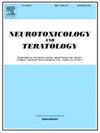Lasting effects of adolescent social instability stress on dendritic morphology in the nucleus accumbens in female and male Long Evans rats
IF 2.8
3区 医学
Q3 NEUROSCIENCES
引用次数: 0
Abstract
Social instability stress (SS) in adolescence in rats leads to long-lasting changes in social behaviour and reward-related behaviour relative to control rats. Given the role of the nucleus accumbens (NAc) in such behaviours, we investigated the morphology of medium spiny neurons (MSNs), which are most neurons in the NAc, in adult female and male rats exposed to SS in adolescence. Irrespective of sex, SS rats had increased number of dendritic spines in both the core and shell regions of the NAc (2.3 % and 18.1 % increase, respectively). In the core, SS rats had a 16 % reduction in the total dendritic lengths of MSNs, whereas in the shell, SS rats had a greater dendritic length closer to the soma, and particularly in SS female rats, whereas the opposite was found farther from the soma (SS 10.6 % > CTL overall). Although the extent to which such structural changes may underlie the enduring effects of SS in adolescence requires investigation, the results add to evidence that changes to the social environment in adolescence can determine adult neuronal structural.
青春期社会不稳定应激对雌性和雄性 Long Evans 大鼠脑核树突形态的持久影响
与对照组大鼠相比,青春期大鼠的社会不稳定应激(SS)会导致其社会行为和与奖赏相关的行为发生长期变化。鉴于神经核(NAc)在这些行为中的作用,我们研究了在青春期暴露于社会不稳定应激的成年雌性和雄性大鼠的中刺神经元(MSNs)的形态,中刺神经元是NAc中的大部分神经元。无论性别如何,SS大鼠NAc核心区和外壳区的树突棘数量都有所增加(分别增加了2.3%和18.1%)。在核心区,SS 大鼠 MSN 的树突总长度减少了 16%,而在外壳区,SS 大鼠靠近体节的树突长度更大,特别是在 SS 雌鼠中,而在远离体节的地方则相反(SS 总长度为 10.6%>CTL)。虽然这种结构变化在多大程度上可能是 SS 在青春期的持久影响的基础还需要研究,但这些结果进一步证明,青春期社会环境的变化可以决定成年后的神经元结构。
本文章由计算机程序翻译,如有差异,请以英文原文为准。
求助全文
约1分钟内获得全文
求助全文
来源期刊
CiteScore
5.60
自引率
10.30%
发文量
48
审稿时长
58 days
期刊介绍:
Neurotoxicology and Teratology provides a forum for publishing new information regarding the effects of chemical and physical agents on the developing, adult or aging nervous system. In this context, the fields of neurotoxicology and teratology include studies of agent-induced alterations of nervous system function, with a focus on behavioral outcomes and their underlying physiological and neurochemical mechanisms. The Journal publishes original, peer-reviewed Research Reports of experimental, clinical, and epidemiological studies that address the neurotoxicity and/or functional teratology of pesticides, solvents, heavy metals, nanomaterials, organometals, industrial compounds, mixtures, drugs of abuse, pharmaceuticals, animal and plant toxins, atmospheric reaction products, and physical agents such as radiation and noise. These reports include traditional mammalian neurotoxicology experiments, human studies, studies using non-mammalian animal models, and mechanistic studies in vivo or in vitro. Special Issues, Reviews, Commentaries, Meeting Reports, and Symposium Papers provide timely updates on areas that have reached a critical point of synthesis, on aspects of a scientific field undergoing rapid change, or on areas that present special methodological or interpretive problems. Theoretical Articles address concepts and potential mechanisms underlying actions of agents of interest in the nervous system. The Journal also publishes Brief Communications that concisely describe a new method, technique, apparatus, or experimental result.

 求助内容:
求助内容: 应助结果提醒方式:
应助结果提醒方式:


